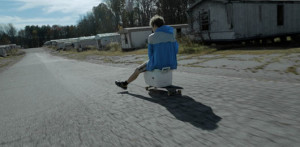By Christopher Sharrett.
While watching Daniel Peddle’s very interesting Sunset Edge (2015), I couldn’t help but think of F.R. Leavis’s reaction to George Eliot’s final masterpiece Daniel Deronda (1876). He argued (very wrong-headedly) that the two “halves” of the novel didn’t cohere, and that the “Zionist half” should be cut away, leaving us a very credible novel entitled Gwendolyn Harleth. Leavis’s sin here struck me as one of impatience, and we must deal with the work an artist presents, not what we want to reinvent.
 I indeed entertained the Leavisian impulse as I considered Sunset Edge, which seems, in its own first half, to be a modest but brilliantly observed essay on young people in this new, often deplorable century. Reviews discussing the film claim that the four teenagers who are its subjects are “alienated,” a word so casually flung about. The adult world is absent, often the case in teen-pics as adults become irrelevant, but the three boys and one girl get along; they chat and play with their meager toys, and get by in the wasteland (in North Carolina) they occupy—an abandoned trailer park consisting, very interestingly, of a single concrete lane (which the kids use for skateboarding), framed on either side by rows of dismounted, rotted trailers, all abandoned. They are single-story, rectangular dwellings that people of the lower middle class once fashioned into homes. Were they abandoned as the nation went into its deindustrialized phase? This seems the implication, as cinematographer Karim Lopez observes the debris that the kids pick through, much of it remnants of old and recent popular culture, but including decayed furniture and kitchen utensils, the materials that the absent occupants used for subsistence.
I indeed entertained the Leavisian impulse as I considered Sunset Edge, which seems, in its own first half, to be a modest but brilliantly observed essay on young people in this new, often deplorable century. Reviews discussing the film claim that the four teenagers who are its subjects are “alienated,” a word so casually flung about. The adult world is absent, often the case in teen-pics as adults become irrelevant, but the three boys and one girl get along; they chat and play with their meager toys, and get by in the wasteland (in North Carolina) they occupy—an abandoned trailer park consisting, very interestingly, of a single concrete lane (which the kids use for skateboarding), framed on either side by rows of dismounted, rotted trailers, all abandoned. They are single-story, rectangular dwellings that people of the lower middle class once fashioned into homes. Were they abandoned as the nation went into its deindustrialized phase? This seems the implication, as cinematographer Karim Lopez observes the debris that the kids pick through, much of it remnants of old and recent popular culture, but including decayed furniture and kitchen utensils, the materials that the absent occupants used for subsistence.
The film comes close to the “ruin porn” genre of still photography, that odd yet compelling emanation of postmodern culture that enjoys wallowing in the collapse of the industrial capitalist world (as if to say “I told you so!”), figured in images of no-longer-useful skyscrapers, homes, and automobiles abandoned to the elements, the markers of capitalism’s endgame. The careful framing of several trailers recall the work of William Eggleston, Stephen Shore, and Gregory Crewdson, chroniclers of postmodern rural and urban collapse. But there is too strong a sense of melancholy in this film to permit that sort of indulgence. As the teenagers kick through the remains of the trailers we are asked to speculate: do they wonder about the past (in an era that tends to deny it)? Do they think about the tenuous nature of their own futures? What we know for sure is that they are alive, interested in each other.
 There are two fine set pieces in Sunset Edge, the most interesting a kind of playful lecture by Will (William Dickerson) on the nature of the cosmos. Using a plastic orange and some gum drops, he explains the relationship of the earth and sister planets to the sun, ultimately arguing that the earth is a mere speck in the scope of things, and the kids and their neighborhood some sort of indeterminate subatomic matter. This might read like a Lovecraftian moment of cosmic horror, as young people are asked by one of their own to glance into the void, but the kids’ relationship to each other sustains them, informing us that their playfulness, the lived moment, is alone sufficient—although one can easily argue that the implicit notion here is of a punkish “no future.”
There are two fine set pieces in Sunset Edge, the most interesting a kind of playful lecture by Will (William Dickerson) on the nature of the cosmos. Using a plastic orange and some gum drops, he explains the relationship of the earth and sister planets to the sun, ultimately arguing that the earth is a mere speck in the scope of things, and the kids and their neighborhood some sort of indeterminate subatomic matter. This might read like a Lovecraftian moment of cosmic horror, as young people are asked by one of their own to glance into the void, but the kids’ relationship to each other sustains them, informing us that their playfulness, the lived moment, is alone sufficient—although one can easily argue that the implicit notion here is of a punkish “no future.”
The second moment, preceding what I just described, shows the kids playing with an enormous Big Gulp plastic soda container. They fill the soda “base” with an assortment of junk food—candy, artificial flavors, and assorted, marginally digestible products of the industrial food machine. The size of the container—about that of circular waste cans in public buildings—makes us note the villains of the piece just offstage, the food manufacturers who think it fine to subject children—and all of us—to barbarism. But the kids know they are playing with junk, treating the container and its contents as waste, a “dare” as a boy takes a sip. Yet they know it’s their food, what the world has deemed acceptable for them to consume.
 At about the halfway point we see a farmhouse occupied by an aging man, and a young Latino boy named Manuel. The man instructs the boy to eat his cereal. We are clearly entering the territory of American Gothic, already introduced by the first image, that of an aging woman, whose tendril-like long white hair floats about in slow motion. Reviewers seem to be unable to avoid citing David Lynch in explaining this image and the rest of the film, as if Lynch’s obscurantism was the first manifestation of compelling, unconventional imagery in the cinema. The old woman seems to “haunt” the film, an image of age—and death—that contradicts the vitality of the young people while complementing the oblique serial killer narrative, which offers quick visual asides rather than storytelling.
At about the halfway point we see a farmhouse occupied by an aging man, and a young Latino boy named Manuel. The man instructs the boy to eat his cereal. We are clearly entering the territory of American Gothic, already introduced by the first image, that of an aging woman, whose tendril-like long white hair floats about in slow motion. Reviewers seem to be unable to avoid citing David Lynch in explaining this image and the rest of the film, as if Lynch’s obscurantism was the first manifestation of compelling, unconventional imagery in the cinema. The old woman seems to “haunt” the film, an image of age—and death—that contradicts the vitality of the young people while complementing the oblique serial killer narrative, which offers quick visual asides rather than storytelling.
There is more to the story of Manuel—who is seen as a near-man and, through flashbacks, a boy experiencing the older man (a father?, a caregiver?, an image of the Anglo-American world colonizing Mexico?). In the interest of avoiding “spoilers,” I’ll refrain from saying anything more about the serial killer plot and the film’s outcome (I find the “twist” unsatisfactory). Suffice it to say that the film darkens as the day ends, the boys reappearing in hooded rubber suits for a round of paintball. Their sleek silhouettes give the film a science fiction air, their paintball guns menacing as the film asserts Thanatos as a reminder, particularly in a moment of US history where mass shootings are a weekly media ritual, that the death-wish will overcome life, sexuality, the dream of utopia— always best rendered in images of children at play, even under a cloud of doom.
I prefer to read the film positively, as offering us hope embodied in the young, who are clear about what surrounds them, and not about to succumb to the awful sins of their American forbears.
Christopher Sharrett has taught film for many years at Seton Hall University. He writes often for Film International.

